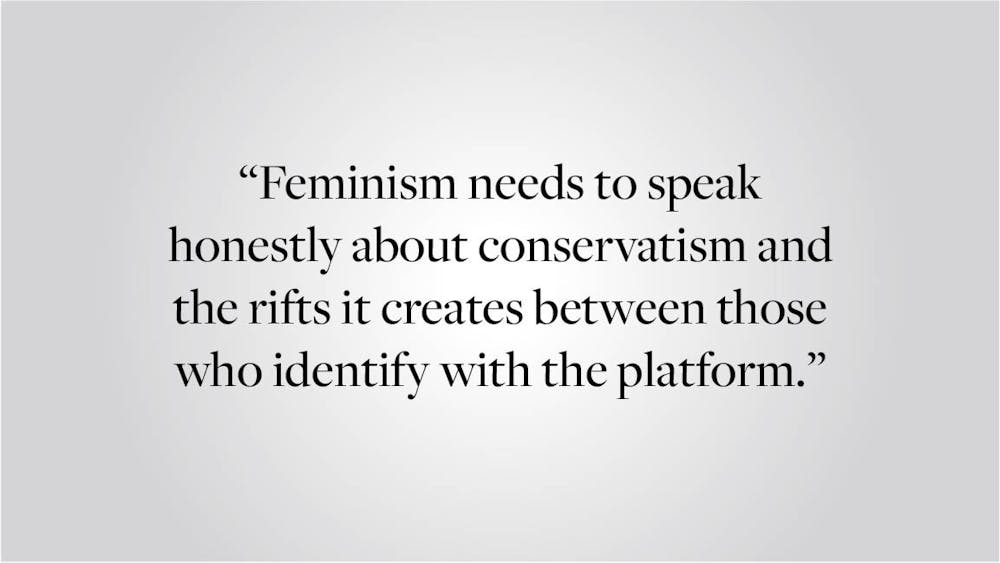This year’s Virginia gubernatorial race between Democrat Terry McAuliffe and Republican Glenn Youngkin was a nail-biter. Coming at a critical juncture in post-Trump politics, this race had serious implications for the upcoming midterms and state legislation on gun control and abortion. Growing up across the river in Washington D.C., I found myself especially invested. So on Nov. 2, I tracked the race and watched the numbers roll in. Hours passed, and it slowly but surely became apparent: Youngkin would win, bolstered by the support of white women. He will become only the fourth Republican governor of the state over the past 40 years. I closed my laptop, knowing that tweets and articles were already flooding in. Democrats were shocked, and #WhiteWomen trended on Twitter — but nothing about the evening’s results should have been surprising. This race wasn’t a fluke but rather a critical case study on the role of white female voters. Youngkin’s victory demonstrates the extent to which politics can expose the deep divides in contemporary feminism.
Despite 42% of Republican women identifying as feminists, women’s issues and the feminist movement have long been considered liberal territory. I was at the original Women’s March in 2017, perched in a tree, watching a sea of pink pussy hats that seemed to stretch without end across the National Mall. It was exhilarating to be there — a cathartic release of fear and frustration with the misogyny and conservatism that newly-elected President Donald Trump represented. It seemed like a promise for an energetic and concerted movement of progressive social change. With Trump in the White House, why wouldn’t women have been more unified than ever? But the years since have made apparent the disconnect between the mainstream perception of feminism represented by the March’s pussy hats and “grab them by the ballot” signs, and how female voters actually engage with American politics.
Youngkin overcame a deficit in the polls and rallied in the final weeks of his campaign by striking a chord with white women through his renewed focus on social and cultural issues. In particular, he articulated a conservative vision of education that appealed to white mothers, proposing abolishing mask mandates and banning Critical Race Theory — and literature by Toni Morrison — in the classroom. This approach to education is a staple of a conservative feminism that emphasizes traditional gender roles and family values alongside economic empowerment for women. The results of this approach were striking: 74% of white women without college degrees voted for Youngkin, and there was a 13-point swing among white Virginian women overall toward the Republican party.
Part of the shock comes from the fact that — even with feminism broadly considered a liberal movement — ‘women’ as a demographic are considered a neutral force in bipartisan politics. Jane Junn, a professor of political science and gender studies at the University of Southern California, describes the female voter as “the one swing voter” in recent American elections. However, looking deeper into the category of ‘women’ reveals that political patterns at the intersections of race and gender are far more stable. Black women, in particular, have been characterized as the “backbone of the Democratic party” and consistently turn out in large numbers to vote blue. The white female demographic has also been consistent, voting Republican in 16 of the last 18 presidential elections. And though many white women may have decried Trump’s election, between 2016 and 2020 their support of his presidency increased. Though this insistence on interpreting politics through identity may seem reductive, as demographics can generalize and create endless categories that may be more divisive than informative, ignoring these distinctions would be equally problematic. Intersectional identities aren’t just predictive polling tools; in this case, they provide insights into the conflicting priorities and patterns of exclusion within the feminist movement — conflicts that need to be reconciled for the movement to progress holistically.
The progress made on feminist issues such as the wage gap, anti-rape policy and trans rights is often due to political advocacy work done by non-white women. In contrast, Professor Jatia Wrighten of Virginia Commonwealth University noted that white women more often than not promote legislation serving their own interests, but not those of women overall. These divisions are representative of the feminist movement’s struggles to operate intersectionally. And even the act of identifying that struggle becomes challenging when many cis, white feminists identify with their womanhood but ignore the power and privilege of their whiteness, “dodg(ing) their own complicity,” per writer Lyz Lenz. This enables the types of fear that Youngkin capitalized on — fears of trans women in bathrooms and CRT curricula. The fact that his stance on CRT was crucial to his victory is telling. White women aren’t just ignoring racial issues; many of them are actively voting in accordance with racialized anxieties — and against the interests of women of color.
The outcome of the Virginia gubernatorial may be nothing new. Still, this time, the message is unmistakable: Progressivism is not inherent to any one identity, and certainly not that of womanhood. Feminism needs to speak honestly about conservatism and the rifts it creates between those who identify with the platform. Likewise, white women can no longer hide behind their gender without acknowledging the effects their ballots and beliefs have on a larger electorate.
Alissa Simon ’25 can be reached at alissa_simon@brown.edu. Please send responses to this op-ed to letters@browndailyherald.com and op-eds to opinions@browndailyherald.com.
Clarification: Due to a technical error, a previous version of this article contained a comment from an editor within the text that has since been removed.





